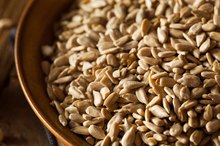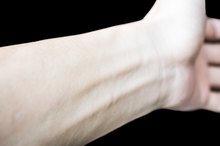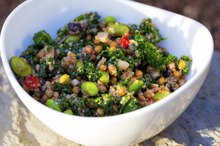Gluten Intolerance, Skin Hives & Hemochromatosis
Gluten is a complex protein found in wheat, rye and barley. Gluten intolerance is a broad term that refers to different degrees of gluten sensitivity. Celiac disease is an autoimmune condition characterized by severe gluten intolerance. Both celiac disease and gluten intolerance can cause a range of symptoms, including hives. Celiac disease also often co-exists with a condition known as hemochromatosis, a hereditary disease occurring when your body absorbs too much iron.
Gluten Intolerance vs. Celiac Disease
Gluten intolerance is caused by an inability to digest gluten, resulting in a range of symptoms, including hives, diarrhea, bloating, gas, abdominal cramps and nausea. Celiac disease is the most severe form of gluten intolerance that occurs due to a malfunction in the body's autoimmune response. If you have celiac disease, you may experience symptoms associated with gluten intolerance on a more severe level. Because celiac disease can cause problems with the absorption of many minerals and vitamins, you may also develop additional symptoms over the course of time, including depression, hair loss, fatigue and nosebleeds, according to PubMed Health.
Hives and Gluten Intolerance
Are Sunflower Seeds a Food High in Iron?
Learn More
Hives, also known as urticaria, are raised, itchy skin bumps that often occur due to an allergic reaction. During an allergic reaction, your body releases a substance known as histamine. Histamine causes your skin to swell due to the dilation of the small blood vessels in your skin. While hives often go away on their own, medical treatment may sometimes be required, especially if they last for more than a day, recur for a month or longer, or are accompanied by anaphylaxis, a life-threatening allergic response, according to the Cleveland Clinic. Food allergies, including gluten intolerance, are a common cause of hives.
Hemochromatosis and Celiac Disease
Many patients with celiac disease have iron deficiency anemia, a condition characterized by the body's inability to absorb iron. At the opposite end of the spectrum is a condition known as hemochromatosis, a genetic condition that causes your body to absorb too much iron. While it's uncommon, two case history reports, published in the April 1993 issue of the "Journal of the Florida Medical Association" and in the February 2004 issue of the "European Journal of Gastroenterology and Hepatology," suggest that hemochromatosis may also be present in a small number of patients with celiac disease.
Hemochromatosis Symptoms
Iron Deficiency & Skin
Learn More
Hemochromatosis can cause symptoms that can resemble some of those related to gluten intolerance: abdominal pain, fatigue, lack of energy, hair loss and joint pain. A variety of tests can diagnose hemochromatosis, including blood tests, physical examinations and echocardiograms. Consult your doctor if you think you may be suffering from hemochromatosis or gluten intolerance.
Related Articles
References
- Health.com: Will a Gluten-Free Diet Improve Your Health?
- MedlinePlus: Hives
- Cleveland Clinic: Urticaria (Hives) and Angioedema
- Journal of the Florida Medical Association: Hemochromatosis and Celiac Sprue: Case Report
- European Journal of Gastroenterology and Hepatology: Coeliac Disease and Hereditary Hemochromatosis: Association and Implications
Writer Bio
Ashley Miller is a licensed social worker, psychotherapist, certified Reiki practitioner, yoga enthusiast and aromatherapist. She has also worked as an employee assistance program counselor and a substance-abuse professional. Miller holds a Master of Social Work and has extensive training in mental health diagnosis, as well as child and adolescent psychotherapy. She also has a bachelor's degree in music.








